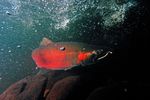Photo: A coho salmon in spawning colors. The National Marine Fisheries Service says that continued use of insect-killing chemicals containing carbaryl or methomyl likely jeopardizes dozens of endangered fish species — including Chinook salmon, coho salmon, sockeye salmon, and steelhead in the Columbia, Willamette and Snake rivers. Rick Swart / Oregon Department of Fish and Wildlife
Carbaryl and methomyl were found to jeopardize endangered Chinook and coho salmon, among others
Federal researchers have found that two widely used pesticides significantly harm endangered Northwest salmon and steelhead species. The opinion could lead to a change in where and how the pesticides can be used.
The National Marine Fisheries Service issued a draft of its biological opinion Thursday concluding that continued use of insect-killing chemicals containing carbaryl or methomyl likely jeopardizes dozens of endangered fish species — including Chinook salmon, coho salmon, sockeye, and steelhead in the Columbia, Willamette, and Snake rivers.
Carbaryl and methomyl are insecticides commonly used on field vegetables and orchard crops. Both are used on agricultural land across the Willamette Valley, the Columbia River Gorge, and southeastern Washington, according to federal data.
The opinion could lead to a change in where and how the pesticides can be used.
The draft opinion says carbaryl is likely to jeopardize 37 listed species and methomyl is likely to jeopardize 30 listed species, and both are likely to harm or destroy many areas designated as critical habitat for endangered species. The fisheries service recommends either prohibiting the chemicals within 300 meters (about 325 yards) of species’ habitat or implementing mitigation practices, like expanding vegetation ditches as buffers or using tools that reduce runoff.
A coho salmon in spawning colors. The National Marine Fisheries Service says that continued use […]
Full article: Federal researchers say two widely used pesticides harm many endangered fish species

